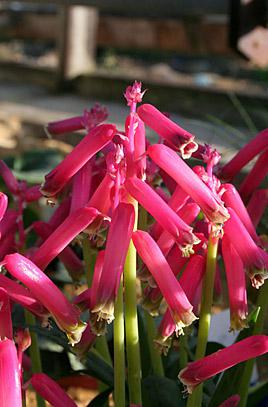Lachenalia bulbifera

Description
One of the most striking and robust members of this diverse group, Lachenalia bulbifera is an easily grown bulbous plant that really deserves a place in patio containers, window boxes and rock garden pockets.The long, tubular flowers of Lachenalia bulbifera are specialized for pollination by sunbirds, especially lesser double-collared sunbirds (Nectarinia chalybea) that feed on nectar contained in the base of the perianth tubes. The sturdy flower stems of L. bulbifera are easily able to support the weight of visiting sunbirds that cling to the stems while probing the flowers for nectar.
The bulbs of Lachenalia bulbifera are highly susceptible to infestation by mealy bugs, eventually resulting in disintegration of the bulb if not treated timeously. Mealy bugs are also transmitters of viral disease and are often spread from one plant to another by ants. An unsightly rust fungus (Uromyces lachenaliae) sometimes attacks the leaves when grown under insufficiently well-aerated conditions. Fungal diseases of the bulbs are usually the result of a poorly drained growing medium and failure in maintaining a dry summer rest period. The bulbs are also sometimes taken by porcupines and mole rats.
Propagation instructions - cuttings
Lachenalia bulbifera is a rewarding species under cultivation provided a few simple points are borne in mind. The bulbs are deciduous and winter-growing, and are completely dormant during the summer months. They should be planted in early autumn (March to mid-April in the southern hemisphere). The top of the bulb should rest 2-3 cm below the surface. The growing medium must be well aerated and drain rapidly; a recommended soil mixture is equal parts of finely sifted, well-decomposed compost and river sand/silica sand (swimming pool sand), and it is best to plant the bulbs in a layer of pure river sand or silica sand.
Propagation instructions - seeds
Propagation is easily achieved by means of bulb offsets that form towards the end of the growing period, as well as by bulbils that develop along the margins of the leaf bases; bulbils also develop at the tips of subterranean stolons produced from the base of the bulb. These can be removed during the summer dormant period and be replanted separately in autumn. Seeds can be harvested from capsules as soon as they split open in late spring and should be stored until sowing time in autumn. The seeds are best sown in deep seed trays in the same mixture recommended for mature bulbs, and will germinate within two to three weeks, if fresh. Flowering from seed usually occurs in the third season.
Sources and references
Scientific name
Lachenalia bulbifera
Common name(s)
red lachenalia
Features
- Good potplant
- Suitable for clay soil
- This is a bird-friendly species
- This will attract honey bees
- Will attract sunbirds
